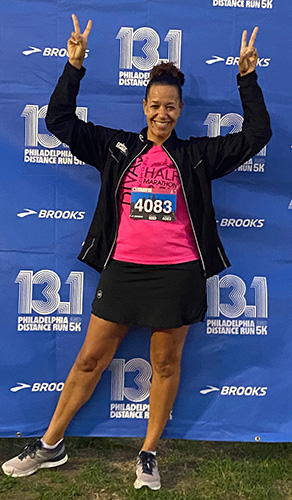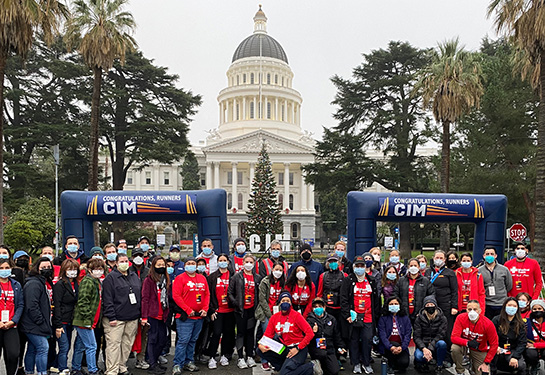Running tips from a sports medicine physician
From CIM medical director to CIM participant: Brandee Waite shares her own running routine
Since 2014, UC Davis Health physicians, staff and other volunteers have served as the medical team for the California International Marathon (CIM), ready to care for roughly 10,000 runners at the event. For eight years, UC Davis Health Sports Medicine Director Brandee Waite, a radio at her hip, has been the race’s medical director. But this Sunday, she’ll run the marathon relay (equal to roughly a half marathon) at the CIM herself.
Waite, a professor in the Department of Physical Medicine and Rehabilitation, will split the marathon route with her husband, Mike Sammis. Each is scheduled to run a 13.1-mile leg of the route that takes participants from Folsom to downtown Sacramento.
“This year is a milestone birthday, so I made it a goal of mine to run 50 miles of races in 2022,” Waite said. “It was a goal for the year I turn 50, so I planned to do races spread out over the year ending with CIM.”
Waite had outlined a series of races to run during the year, ending at the CIM. But after getting COVID and a race day migraine, she was forced to adjust her strategy, including adding an unplanned 5K while traveling in Philadelphia.
“Once I complete this race, I’ll end up running 51.5 miles,” Waite said.
This year is a milestone birthday, so I made it a goal of mine to run 50 miles of races in 2022. It was a goal for the year I turn 50, so I planned to do races spread out over the year ending with CIM.” —Brandee Waite
In the days before the CIM, Waite shared some of her own training tips that cover nutrition, hydration and how to avoid common running injuries. Here are the highlights:
Training for races
Don’t overdo it and have a plan. Running is not my go-to cardio activity, so starting off slow and at shorter distances was key. I also made sure to incorporate other forms of cardio, in my case, dance, and also included light to moderate strength training sessions in between.
Runners at any stage should focus on a slow, steady progression training program. If you’re just starting out, start with two to three runs per week and increase the distance by no more than 10 percent per week. You can always focus on shorter runs on weekdays, and one longer run on the weekend, making sure to incorporate rest days in between. Also know your limits: The body whispers before it screams, so if something starts feeling uncomfortable, make sure to take the appropriate rest and focus on stretching or icing to aid recovery.
Warming up, cooling down and stretching
Making sure your muscles are warmed up before a run is always a good idea. I always start with a brisk five-minute walk before starting a run. Dynamic stretches after a warmup can also be beneficial, especially for your large muscles like your hip flexors and hamstrings. Even with a good warmup and stretching routine, cramps may still happen during a race. It’s better to stop and stretch out the muscle rather than try to keep running until the cramp is so bad it hinders your ability to move.
After a run, I do a five-minute walk to cool down my muscles and allow my heart rate to decrease before doing any stretches on my lower extremities. This helps reduce muscle soreness and improve muscle relaxation after a run.
Nutrition and hydration

My favorite pre-race dinner is Sushi rolls. I find that it is a good mix of carbohydrates, healthy fats and protein, without it being too heavy of a meal on the day before the race.
On race day, I will focus on having some fruit in the morning, which provides good carbohydrates. I also use the Gu pouches to get a bit of a boost and fuel my body every 35-45 minutes during the race.
Good hydration is key. This has been one of the most common issues we’ve seen in the medical tent in prior years. Either people are not hydrated enough, or they have not been drinking a good balance of water and electrolytes, which contributes to both dehydration and cramping of muscles. That said, don’t overhydrate with water alone while running more than 60-90 minutes, that can also lead to stomach discomfort or serious problems with low electrolytes.
My go-to tip is for every two cups of water, drink one cup of a beverage with electrolytes. As we sweat and run, we are losing electrolytes and water alone does not replenish the electrolytes leaving the body.
Shoes matter
Take your time in selecting the shoe that feels best on your feet, even if it means trying on different shoes and walking around the store before making a selection. Make sure they provide good support but place the most importance on what feels best on your feet and replace them after about 350 miles.
Race day tips
Make sure to get good rest the night before and avoid drinking alcohol in the days prior as this affects hydration and the quality of sleep.
On the morning of, I wake up early and have some fruit prior to the race. I take a look at the weather forecast to know what to expect and plan what to wear, whether that’s several layers on colder days or a shell when rain is expected.
Make it fun
I like to have a good playlist to help pump me up, particularly around mile nine when I start feeling the fatigue. It’s never a bad idea to have a good one just in case, whether you’re a runner who listens to music the entire race, or one that prefers to run in silence. Good music can give you the extra push during the final stretch.
Everyone’s music taste is different, but the two songs that are a must on my playlist for CIM 2022 are:
- “Levitating,” by Dua Lipa
- “Run the World (Girls)” by Beyoncé





